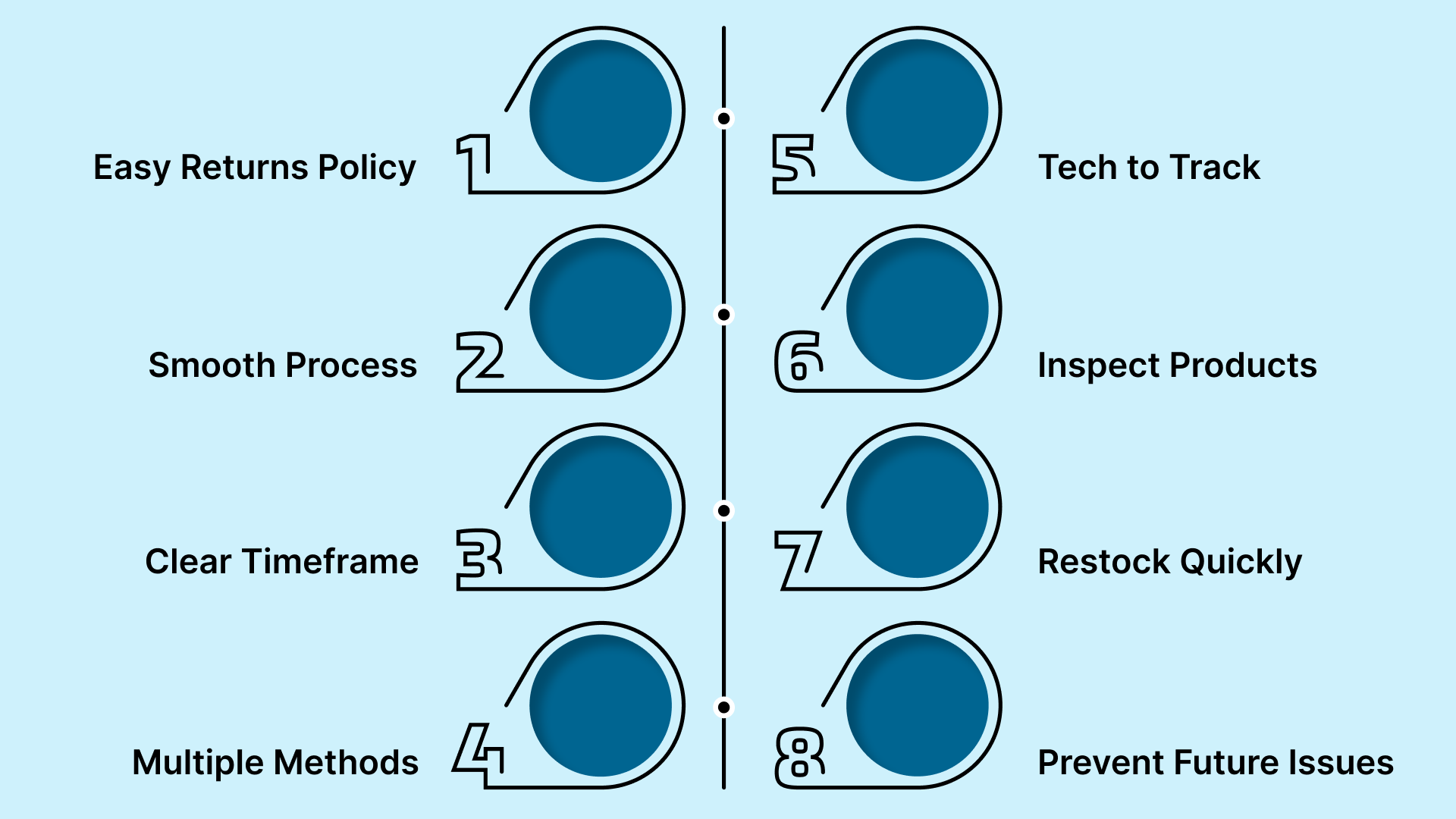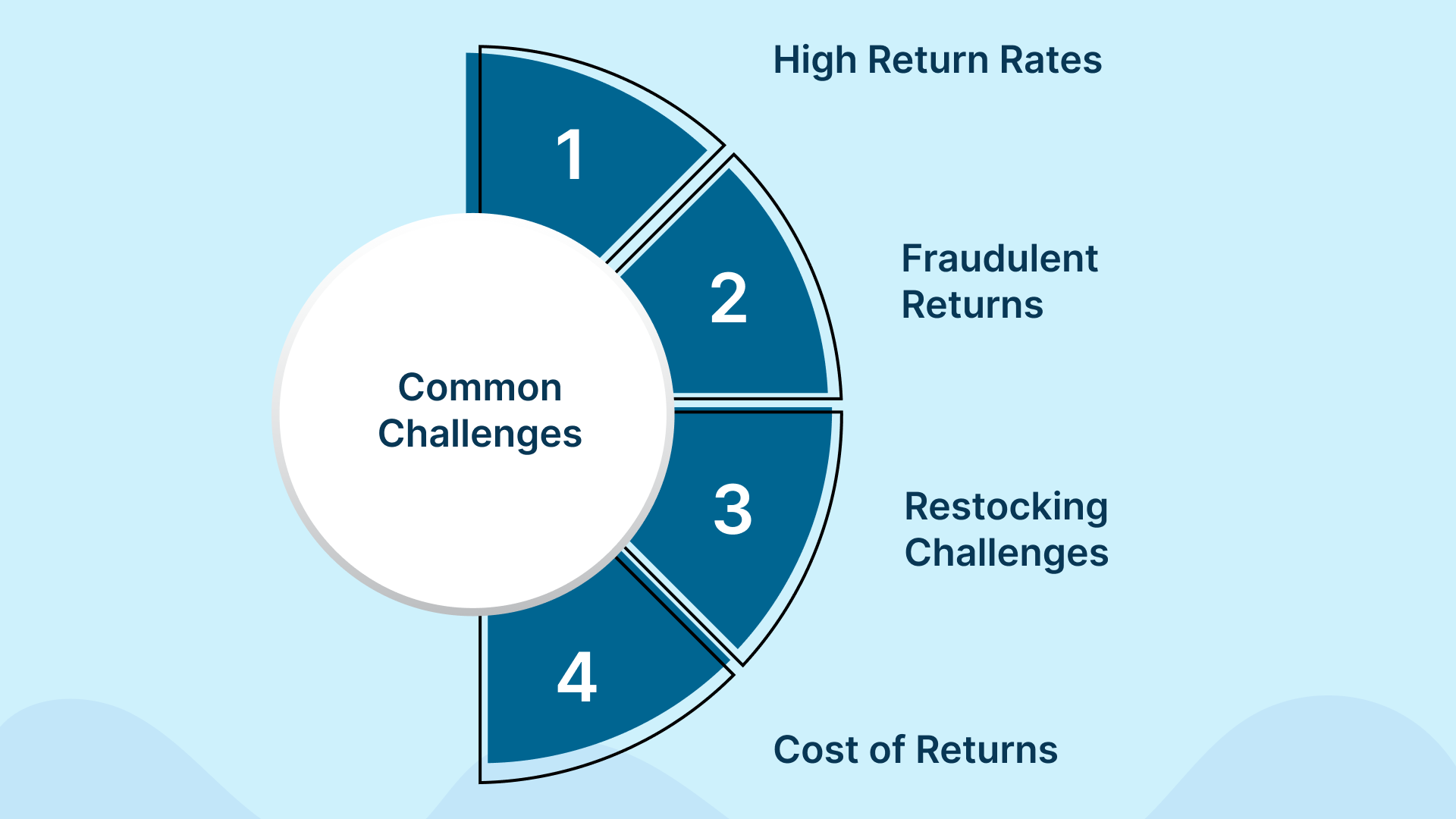Product returns are an inevitable part of e-commerce, but they don’t have to be a liability. When managed well, returns can actually strengthen customer trust and streamline your operations.
In the Philippine e-commerce market, the return rate reached 4.3% in 2024, meaning that for every 100 pesos in sales, 4.30 pesos was refunded. That’s a clear signal that returns management is about operational efficiency, profitability, and customer retention.
In this blog, we’ll walk you through 8 actionable tips to manage product returns more effectively, minimizing friction for your team while keeping customers happy and loyal.
Whether you’re a small online shop or a large e-commerce brand, these strategies will help you turn returns into a competitive advantage.
Product returns management refers to the strategies and processes businesses use to handle customer returns, from the moment a return request is made until the item is refunded, replaced, or restocked.
Efficient returns management goes beyond accepting returned products. It aims to reduce processing costs, maintain customer satisfaction, and minimize the impact on profitability.
In e-commerce, returns are inevitable. Managing them well is essential for building customer trust and loyalty. In fact, the global average return rate for e-commerce was 16.9% in 2024, as reported by the National Retail Federation (NRF) and Happy Returns, highlighting how important it is to have a clear, efficient process in place.
This includes setting transparent return policies, automating processes where possible, handling returned inventory promptly, and keeping customers informed at every step.
For SMEs and online retailers in the Philippines, implementing a streamlined returns system not only reduces costs but also positions your brand as customer-centric and reliable.
Next, let’s explore how you can improve your product returns process and positively impact your bottom line.

Managing product returns effectively creates a smooth, hassle-free experience for your customers while minimizing the operational impact on your business. By optimizing your returns management, you can turn potential challenges into opportunities to improve customer satisfaction, manage processes, and ultimately boost your reputation as a reliable seller.
Here’s the first tip to help you manage returns efficiently:
A clear and straightforward returns policy is key to successful returns management. When customers understand how returns are handled from the outset, it fosters trust. This transparency makes them feel more secure in their purchasing decisions.
Your returns policy should be easy to locate and written in simple, plain language. Include:
For businesses in the Philippines, offering a transparent return policy is crucial, particularly with the rapid expansion of the e-commerce market. A customer-friendly policy helps reduce hesitation during the buying process and encourages repeat purchases.
Why it matters: A clear returns policy boosts customer confidence and leads to higher conversion rates. It helps manage customer expectations, reducing frustration if a return is needed. By keeping things simple and transparent, you enhance the overall shopping experience, which can directly contribute to higher customer satisfaction and long-term loyalty.
A smooth returns process ensures that customers are more likely to return in the future, improving your reputation and boosting customer retention.
A hassle-free returns process is crucial for keeping your customers happy and encouraging repeat business. When a return process is complex or time-consuming, customers may become frustrated, resulting in a negative experience that can harm your brand’s reputation.
To improve customer satisfaction, aim to make the returns process as smooth as possible. Here’s how:
Why it matters: A simplified returns process improves customer satisfaction and builds trust in your brand. Customers who experience a smooth return process are more likely to make future purchases, knowing that they won’t face difficulties if they need to return an item. Simplifying returns encourages transparency, loyalty, and ultimately, a better relationship with your customers.
One of the most critical aspects of effective returns management is establishing clear and reasonable timeframes for returns. Customers should be aware of the exact timeframe for returning a product, and this information should be communicated at the point of purchase.
For example, specify whether customers have 30 or 60 days to return an item, and ensure this is included in the product description and order confirmation emails. Additionally, if your returns policy differs for specific product categories (e.g., clothing, electronics, or perishable items), make sure to highlight these distinctions.
Why it matters: A clear return timeframe helps set expectations and reduces confusion. It minimizes the chances of disputes over whether an item is eligible for return, managing the entire process. By providing a firm but reasonable return window, you allow your customers to make informed decisions without feeling rushed, which can lead to increased customer satisfaction and trust in your brand.
A well-communicated return timeframe fosters transparency, and customers are more likely to buy from a retailer that respects their time and ensures they can make return decisions within a reasonable period.
Providing your customers with a variety of return methods can significantly enhance their experience and increase the likelihood of them completing a return when necessary. Customers value convenience, and the more return options they have, the easier it is for them to resolve any issues with their purchases.
Here’s how you can offer multiple return methods:
Why it matters: Offering multiple return methods gives your customers more control over how they return products, increasing their overall satisfaction and trust in your business. This flexibility also demonstrates that your business values its customers’ time and effort, which can build long-term loyalty.
It reduces barriers and friction in the returns process, making it more likely that customers will feel comfortable purchasing from you again.
Incorporating technology into your returns management can greatly improve efficiency and provide a more organized approach. With the right tools, you can handle returns quickly, track progress, and deliver a better customer experience.
Here’s how to use technology effectively:
Why it matters: Using technology speeds up the returns process and gives you valuable insights into your product performance. By tracking returns effectively, you can improve product quality, reduce return rates, and ensure customers have a hassle-free return experience.
To maintain customer satisfaction and keep your business operations running smoothly, it’s crucial to inspect returned products quickly. A fast and thorough inspection process ensures that items are either restocked or flagged for issues, preventing unnecessary delays.
Here’s how to improve your inspection process:
Why it matters: Speedy inspections help minimize the time returned products spend in limbo, allowing you to either resell, refurbish, or recycle items quickly. Not only does this improve your inventory flow, but it also gives your customers prompt updates on the status of their return, enhancing their experience and trust in your business.
Efficiently restocking returned items is crucial for keeping your inventory up-to-date and meeting customer demand. The faster you process and restock returns, the quicker they can be made available for sale again, improving your product availability and reducing stockouts.
Here’s how to restock returns quickly:
Why it matters: The faster you can restock returned items, the quicker you can meet customer demand, increasing sales opportunities and reducing inventory costs. This practice ensures you don’t lose potential revenue by leaving returned products sitting unused for too long. It also helps maintain inventory accuracy, leading to better forecasting and customer satisfaction.
Analyzing returns data is an invaluable tool that allows you to uncover patterns and identify recurring problems with your products or processes. By understanding why items are being returned, you can take proactive steps to prevent future issues and improve your overall customer experience.
Here’s how to effectively use returns data:
Why it matters: By learning from returns data, you can reduce future returns, enhance product offerings, and create a smoother shopping experience. This minimizes operational costs and builds customer trust, knowing you’re actively addressing their concerns. Moreover, it can prevent loss of sales from customers who might otherwise hesitate to buy due to recurring issues.
To ensure the success of your returns process, it’s essential to focus on best practices and also recognize and address the common challenges that may arise. Here’s a look at some of the key obstacles businesses face in managing product returns effectively.
Ready to optimize your product returns management?
Schedule a meeting with Inspire Solutions Asia todayAlso Read: What Does RTS Mean in Delivery & Shipping?

Managing product returns is not always a straightforward process, especially for businesses scaling in a competitive market. To ensure smoother operations, here are some of the most common challenges you might face when managing product returns and how they can be addressed effectively:
Handling a high return rate can be challenging, especially in the e-commerce space. Products might be returned due to various reasons, from quality issues to customer dissatisfaction. Managing returns in such cases can add significant costs to your business operations.
Solution: By improving product descriptions, images, and detailed sizing charts, you can help set clear expectations and reduce the likelihood of returns.
Some customers may attempt to exploit return policies by returning items that were used or damaged. This can be especially problematic for businesses with generous return windows.
Solution: Implementing robust return verification methods, such as requiring proof of purchase or inspecting returned goods more carefully, can help mitigate fraud.
When returned items are not inspected promptly, it can create a backlog of products that cannot be resold quickly. This affects inventory management and can lead to storage issues.
Solution: Implement a clear restocking process and ensure items are returned to inventory as quickly as possible, ready to be sold again.
Returns can be costly, particularly when dealing with shipping, restocking, and potentially damaged products. This puts pressure on your profit margins.
Solution: Minimizing return shipping costs by offering more efficient methods and providing customers with easy, low-cost return options can reduce overall expenses.
Managing returns efficiently can be challenging, but with the right tools and strategies, businesses can reduce disruptions and improve the overall experience. The next section explores how Inspire Solutions Asia supports seamless returns management through integrated solutions tailored to your operational needs.
Facing challenges with product returns?
Contact us todayAt Inspire Solutions Asia, we understand that effective returns management is crucial for maintaining customer satisfaction and ensuring smooth e-commerce operations. That’s why we offer tailored solutions to simplify and smooth returns. Whether you’re an online retailer or a growing SME, we help you reduce operational friction and improve your returns handling.
Let Inspire Solutions Asia optimize your returns management process. Whether it’s improving tracking, ensuring quick restocking, or using tech to manage data efficiently, we provide the end-to-end solutions that help you succeed in a competitive e-commerce environment. Contact us today to learn how we can assist you in simplifying your returns process and improving operational efficiency!
Managing product returns effectively is essential to delivering a seamless customer experience and maintaining operational efficiency. By applying strategies like clear return policies, flexible return methods, and efficient inspection and restocking processes, you can reduce disruptions and strengthen customer trust.
Returns don’t have to be setbacks, they can be opportunities to improve your operations and build long-term loyalty.
Streamline your returns management, reduce operational bottlenecks, and enhance efficiency with our tailored services
Schedule a meeting today.Product returns management refers to the strategies and processes used by businesses to handle returns efficiently, from the moment a customer requests a return until the product is refunded, replaced, or restocked. It is important because effective returns management can enhance customer satisfaction, reduce operational costs, and help maintain inventory flow. A streamlined returns process can also improve customer trust and loyalty, ensuring customers feel confident in making purchases.
To keep customers satisfied with the returns process:
These steps help make returns less frustrating and more convenient, encouraging repeat business.
Quick inspection of returned products is crucial for:
Technology can streamline the returns process by:
By using technology, you can reduce manual errors, speed up the process, and gain valuable insights into product performance.
Some common mistakes to avoid in product returns management include:
Avoiding these mistakes helps create a smoother, more efficient returns process, boosting customer satisfaction and reducing operational friction.